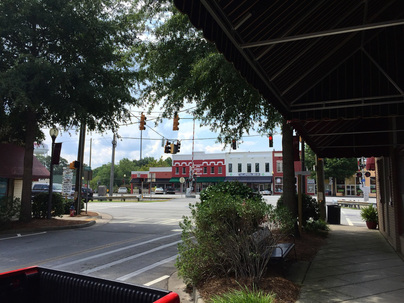|
By Sam Burnham @C_SamBurnham  The Quiet Streets of Tallapoosa The Quiet Streets of Tallapoosa The other night, as I was winding down for the evening I came across an article from NPR News that stated that there are ballot initiatives in several states this election cycle focusing on public transit as an option to alleviate traffic, deal with commuter issues, hopefully decrease the pollution levels in cities, etc. Atlanta is included in this list as it is scheduled to vote on spending $2.5 billion over the next 40 YEARS. Do not adjust your screen, you read that correctly. MARTA is proposing a T-SPLOST to raise $2.5 billion to fund transportation upgrades in Atlanta. 40 YEARS. 40 years isn't a term on a T-SPLOST. 40 years is a sentence at Georgia Diagnostic for murder. 40 years is a typical career length before someone retires. In 40 years people who aren't even born yet will have gray hair and grown kids and will still be paying a penny per two dollars so in the year 2057 people in Midtown can catch a bus to Cabbagetown. We have no idea what technological or financial events might occur to make this project even more absurd than it is in 2016. While I'm somewhat impressed that Atlanta is trying to rook the whole state into this scheme by claiming that somehow traffic on the downtown connector is just as detrimental to the lives of people in Toccoa or Sylvester as it is for Atlantans, I just don't see this option as sustainable. At some point, you reach a limit of how many people will fit in a space. Atlanta's growing water and sewer needs, the space available for development, the food deserts caused by the relative inability of the citizens to produce any of their own food. Atlanta needs far more innovation than multi-billion dollar stadiums and bus routes.  The Architecture of Tallapoosa The Architecture of Tallapoosa This brings us back to our small town model. Even in the idyllic model of a thriving community, the issues with traffic, gridlock, and pollution are minimal. This is just a fact of operating with a small population center. This model is not promoting these mostly abandoned small towns as future metropolises of the future, it is saying that a decentralized economy and workforce are a more effective model or, at the very least, an equally effective model. We aren't looking to upgrade De Soto to Atlanta. We're looking to create a healthy De Soto. As we address food deserts in this model, so many of the communities in question are surrounded by arable farmland. Others are set in the verdant wild-lands of the state. Between hunting, fishing, and agriculture (including residents who till their own gardens) an inhabitant of a 25 square mile community should never be more than a mile or so from fresh nutritious food. There are a lot of good folks in these towns that are already producing volumes of food. Too many of them are marketing their products in Atlanta, Savannah, and Charleston, not because they a bourgeois and want to sell to fancy people and restaurants but because there isn't a customer base in their community. In this model, the farmers quit taking the food to the people because the people come to them. What this model needs is some innovation. There will be a smaller demand for energy as there will be fewer buildings, fewer streetlights, less illuminated signage, less wasted electricity. Fuel will be less of a factor as commutes will be shortened or eliminated. If the grid can be upgraded to accommodate an efficient use of solar, most of these towns could supply much of their own power, especially in the summer. Think 40 years down the road. Atlanta will just be finishing off the aforementioned T-SPLOST package and will be just as crowded and congested as ever, it not more. But in the outlying areas, innovation and a changed mentality toward small communities could have taken hold. Many of the benefits of the big city, such as entertainment and leisure activities, may have made it back to our towns. Rural areas could possibly be holding a substantial voting base and will have more economic pull within the state. The people who made this transformation happen would have returned education and medical care in these areas to effective levels. We have a tendency in the United States to think that bigger is better. We centralize everything. But what happens is we create monstrosities that are not sustainable. They create an economic drain that results in corruption, ineffectiveness, and failure. We deserve better and we can do better. But we have to change the conversation. We can't just fix Atlanta and expect that to solve all our problems. A 40 year package to spend $2.5 billion on a problem that probably can't be solved is an exercise in futility. There are better options available. Let's talk about the 1000 little answers to one big problem. Let's keep the conversation going. More to come.
0 Comments
Leave a Reply. |
Sam B.Historian, self-proclaimed gentleman, agrarian-at-heart, & curator extraordinaire Social MediaCategories
All
Archives
November 2022
|




 RSS Feed
RSS Feed
